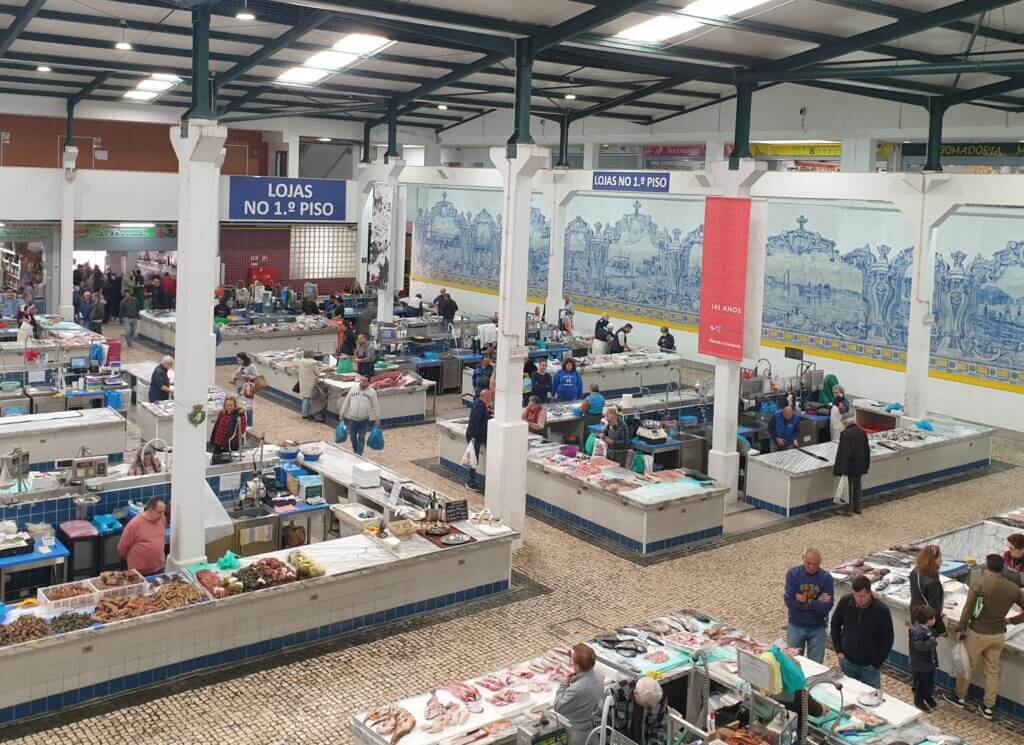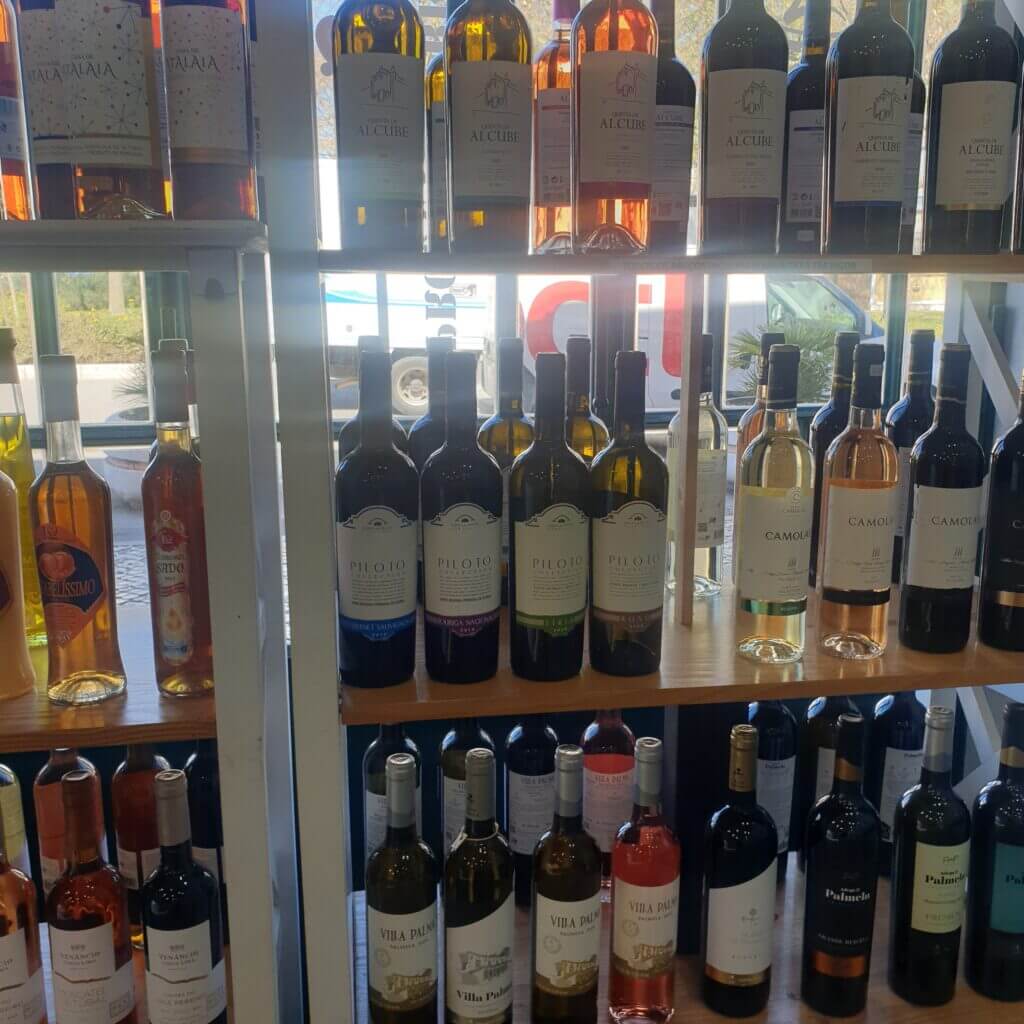Introduction
My first memories of Setúbal fixate on a rose-pink building. In the way people lingered, I knew it was a local market. Carried by a stream of shoppers – regulars with their reusable bags; travellers announced by cameras on a strap – I arrived at Setúbal Market, mesmerised.
Avoiding eye contact, I bounced between stalls, striking out aisle after aisle until I’d passed organic fruit and vegetables; cheeses; bread, and at the rear: iced fish, lots of it. But blind-sighted by wonder, I bought the wrong things at the wrong time of year and never dared to ask for advice.
Only when I went with a Portuguese friend, did I learn how to wise-buy at the Mercado Do Livramento (otherwise plainly known as ‘the Mercado’ or the Livramento Market in English).
Here’s a Foodie’s guide on where to find everything you need for the freshest almoco caseira (homemade lunch) on the Sado River.

Hand-Picked Fruit and Vegetables
Although you’ll initially be tempted by coolers of sugar-swirled biscuits, don’t stop yet. Because the best spot to buy fresh fruit and vegetables is in the outer middle.
Here, you’ll find the sweetest oranges, a rainbow of root vegetables, and a vendedora (seller) who is the ultimate businesswoman: delivering orders, collecting payments and recording cash flows in a frenzy. Be loyal to the left if you care about small producers – these heroes grow yards of fruit and vegetables on their farms in Palmela and Azeitão, and sell the surplus at the market.
Meanwhile, full-time sellers in the middle are wholesalers in disguise. How do you tell the difference?
Avoid suspiciously perfect fruit, indifferent to season, with mighty prices to match.
Truly Tip #1
Best aisles: outer left and right.
Average price: one euro per kilogram.
What to get: azeitonas (olives), salada (lettuce), tomate (tomato), cebolas brancas (white onions); pera (pear), marmelo (quince), or the sweeter gamboa variety.

Fresh Fish
Remember what I wrote about never visiting a market?
I meant a fish market.
It’s for this reason that once, in the Mercado do Livramento, I mistook a beheaded swordfish carcass for a stone sculpture. Drawn into dead eyes, I noticed its glistening brain and shut my mouth (just in time).
Squeamish story aside, it’s a popular place to buy a myriad of freshwater and saltwater types. Because the market’s fish vendors are clever folk who buy their fresh produce at the crack of dawn. And coat every fin, tail and claw in tons of ice.
Get to know your vendors and you might be trusted with a locals-only secret. In doubt, seek bright fish eyes as a clue.
Truly Tip #2
Best aisles: at the back by the mosaic tiles.
Average price: depends on the type of fish.
What to get: carapaus (horse mackerel), sardinhas (sardines), besugo (red seabream), cavala (mackerel), sarda (Atlantic skipjack), linguado (flounder fish), corvina (croaker), choco (cuttlefish), sargo (white seabream), piexe espada (sword fish).

Oh-So-Smelly Seafood
Until now, I’d never crossed over to the wet side of the Mercado with the intention to buy. Maybe it’s because seafood is the trickiest option.
Why?
You have to be 100% sure it’s fresh. So how do you tell?
If the fishy smell is so pungent it makes your nose wriggle in protest, you’re on the right track. Plus, if you offer your eternal loyalty to the vendor, you’ll be pointed to the freshest fish on the stall.
Finally, I took my own advice. One kilogram heavier thanks to a bag of clams and shrimps, I would recreate arroz com marisco (seafood rice): a favourite from the Portuguese coast.

Truly Tip #3
Best aisles: behind the fish aisles at the very back of the Mercado.
Average price: depends on the seafood in question.
What to get: different varieties of camarão (shrimp) from the coast and river, ostras do Sado (Sado River’s oysters), sapateira (crab), santola (crab from Setúbal’s coastline), amêijoas (clams), lagostin (lobster).
Bread, Always
The key to a tasty lunch; bread plays an essential part in Portuguese gastronomy.
An appetizer enjoyed besides azeitonas and cheeses, bread features just as much in the main dishes as it does in the entradas (starters).
So where does one go in the Mercado to buy bread?
You can’t miss the curved glass windows with an assortment of soft cakes, bags of chewy broas, and biscuits laid like bricks.
A lit backdrop lined with dusty loaves displays some of Setúbal’s most adored breads. Swaddled in rustling paper, you might take home Pão de Mafra from its namesake region, white-grained Pão de Torrao from the Alentejo, or Pão de Centeio (rye bread) amongst other freshly baked goods available.
Don’t neglect your bread, or as this old expression warns: “casa onde não há pão, todos ralham e ninguém tem razão // a house where there is no bread, everyone scolds and no one is right”.
Truly Tip #4
Best aisles: enter the Mercado with Pingo Doce behind you. It’s the third row on the left. If you reach the last row, you’ve gone too far.
Average price: more or less 2€ for a traditional loaf, smaller breads for around 0.20€ each, but you’ll pay more for Pão de Milo and seeded breads.
What to get: Pão de Mafra, Pão de Vidigueira, Pão de Torrão, Pão de Centeio, Pão de Especial, Pão de Integral, Pão de Alcacer, Pão de Milho, Pão de Lagoinha.

Cured Cheeses
Lunch at any Portuguese restaurant and chances are, you’ll be offered cheese by the plate.
Though fresh and creamy cheeses are absent, you’ll find a medley of smelly, cured cheeses from Alentejo; softer Queijo Amanteigado de Seia from Serra da Estrela; or local superstar, Queijo de Azeitão from Serra da Arrábida, a cheese made with sheep’s milk.
All of which can be found at the Mercado, and which taste just as good – if not better – bought by you.
Truly Tip #5
Best aisles: enter with Pingo Doce behind you, take the second left, it’s a glass-front stall on the second row.
Average price: Queijo do Azeitão is around 1.70 – 3 euros for smaller cheeses, whilst bigger ones costs up to 10€/kg. Different cheeses have different prices based on the region and size.
What to get: Queijo de Ovelha, Amanteigado Seia, Queijo de Azeitão, Queijo de Evora DOP.

Wine O'Clock
If you want to top up on regional wines at the Mercado, visit Rotas do Sal on Luisa Todi Avenue.
Besides being a 5-star tour operator who takes tourists to see the coveted Setúbal dolphins, Rotas do Sal has an impressive selection of bottles in their street side shop.
A serial sipper, I can assure you that Setúbal’s wines are scrumptious. But, call me simple, I’ve never matched it to my food.
For the best results, drink a light wine that won’t dominate the main fish or meat flavours. Then after your meal, drink a fuller Reserve.
Adega de Palmela and Camolas are two producers that sell Reserve options at the Rotas do Sal shop. Alongside the novel producer, Horácio Simões, and Azeitão vineyard, Quinta de Alcube.
The price, though fair, is more expensive than buying straight from the source.
At Quinta da Alcube, a delicious bottle of Castelão costs 5 euros yet at Rotas do Sal you’ll pay 7 euros. And whilst the creamy red by Palmela Ageda is 5 euros in Palmela’s Casa Mãe Rota dos Vinhos, it costs 8 euros in the shop.
If you were wondering about vinho verde, the Setúbal region is best known for Moscatel, rose, white and red only. And as I discovered in conversation with the shop assistant, mixed Moscatel is also available. Lesser known, this unusual variety brightens a fish lunch without the sugar rush.
Truly Tip #5
Average price: between 2.95 – 7 euros.
Grape varieties: Moscatel, Castelão, Trincadeira, Syrah, Aragones, Cabernet Sauvignon.

Conclusion
A trip to the Livramento Market is to dive, nose first, into Setúbal’s sensational gastronomy. You can easily spend hours inside, participating or people-watching, until you fill your stomach (so to speak).
Now with a roadmap to fresh, you can leap into new habits and reclaim the kitchen. Pair with a tasty wine of your choice and always, a tableful of friends.
Which are your favourite aisles in the Livramento Market?
Share your tips in the comments below!